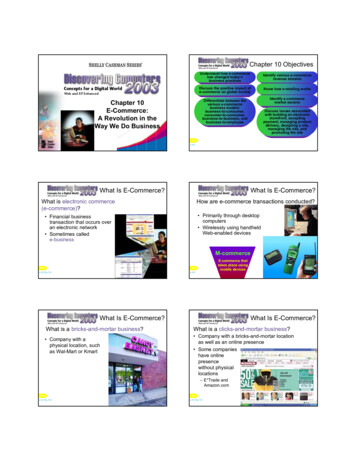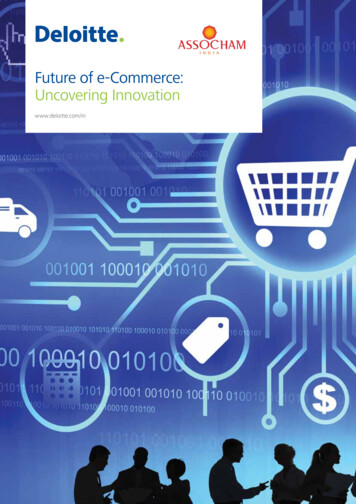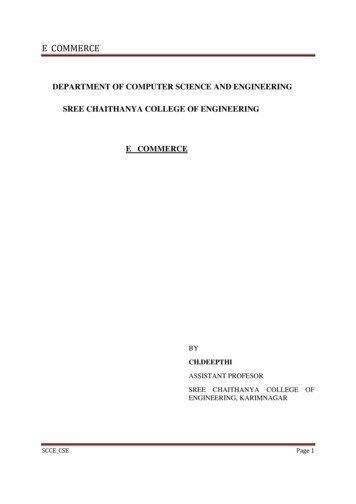
Transcription
November 2009Social Commerce Defined
Social Commerce DefinedPage 2An Introduction to Social CommerceSocial Commerce is a new phenomenon that has taken the e-commerce world by storm.Unlike many technologies to emerge over the years, social commerce has had a rapidadoption. A few years ago, Facebook, Twitter, YouTube and LinkedIn were not commonterms in our vocabulary. Few could have predicted how pervasive the social technologieshave become not only online, but also in our daily lives.Put simply, social commerce is the concept of word-of-mouth, applied to e-commerce.Social commerce has taken word-of-mouth where it never really existed before, theonline shopping world. Customers now are looking for ways to leverage each other’sexpertise, understand what they are purchasing, and make more informed and accuratepurchase decisions. Retailers need to understand their customers and what they expectout of the shopping experience to develop a successful social commerce strategy.This whitepaper will focus on the definition of Social Commerce, the benefits of socialcommerce to retailers, the different components and how IBM has enabled SocialCommerce in WebSphere Commerce Version 7.0.The Basics of Social CommerceSocial Commerce is the marriage of a retailers products and the interaction of shopperswith the content. It comes in many forms, although the most common and adopted isonline ratings and reviews. As the use of the internet has evolved, shoppers have increased their expectations of the retail interaction experience. It is no longer enough tohave standard product descriptions with static text and standard descriptions. Shopperswant detailed product descriptions that include product specifications and informationon how the product works; instructions and how-do tips and videos. Essentially, shoppersare looking for more information to gauge the value they get for their money with specificproducts. Shoppers have transferred the social in-store shopping experience to the onlineexperience and now, expect an interactive and more social experience online.
Social Commerce DefinedPage 3Today’s shoppers are looking for transparency from retailers. Providing the opportunityto share knowledge, insights, thoughts and opinions ensures that retailers are offering amore social experience online and adds significant credibility to a website. As retailersintroduce social commerce to the online experience, it is critical be authentic andgenuine when speaking to shoppers, who are passionate about products and their brand.The social web is here to stay, it’s no longer a young adult phenomenon. In fact, the fastestgrowing demographic on Facebook is now woman between the age of 45 and 55, who alsohappen to hold a big piece of a family’s purse. By personalizing the experience, retailerscan engage shoppers and transform them into brand advocates.Social Commerce Impact on RetailersIn many cases, retailers were on the forefront of social technologies such as enhancedconversion rates after integrating ratings and reviews into product pages. Conversion ratesare one of three primary benefits retailers can enjoy by pursuing a broader social commerce strategy. By making their entire retail experience social, and leveraging the uniquecomponents of social commerce from a technical, application and strategic perspective,retailers can turn their sites into communities, where conversations flourish aroundbrand, product, and lifestyle-oriented content – creating a larger, more vibrant, andmore effective online experience leading to return visits and increased sales.As shoppers have adopted social technologies, merchants and manufacturers haveresponded by providing features such as ratings and reviews and integration to Twitteraccounts, where shoppers share promotions and new products. Companies are innovatingthe shopping experience with social technologies such as a Facebook store and integratedsocial campaigns. Social Commerce is redefining the way brands and retailers are interacting with customers.The Key Components of Social CommerceSocial commerce can deliver several key benefits. Fist, social commerce drives newonline visitors. By deploying a social, search-optimized content on their sites, retailersorganically can increase their search engine page rank and attract site visitors throughthe multitude of new access points created by this content. Custom content with productrelevant topics, categories, and lifestyles – whether created by users or professional content creators – can drive new traffic to the site. For example, a home and garden retailerhosting an article about “How to Build an Outdoor Deck” would attract users searchingfor related terms on major search engines – in turn acquiring highly qualified new sitevisitors. Retail strategists and marketers should examine content as broadening the topof the marketing funnel – building traditional “awareness” – not through print ads ornetwork TV spots, but rather through today’s corollary: search. Understanding thescience of deploying SEO-friendly content is key: even the top position on the secondpage of Google search results gets less than 1% clickthrough rate.
Social Commerce DefinedPage 4The second benefit of implementing a social commerce strategy is increased engagement.This engagement is created primarily by integrating social applications into the core siteexperience of a retail website. By giving shoppers the right tools to interact with productand lifestyle-related content on their social commerce destination, retailers enable thoseshoppers to build preference for that content and the products and brands represented.User profiles, groups, blogs, forums, photos, videos, comments, ratings, reviews andrecommendations are all critical social applications which can be customized, combinedand deployed to power a range of user experiences, including: Shopper Show-and-Tell – Blogs, photos, and comments enable shoppers to sharetheir product experiences ,which helps provide informative perspectives for prospectiveshoppers making purchasing decisions about the product Product Page Discussion – Ratings, reviews, recommendations, and comments powerQ&A-type experiences around products, enabling shoppers and staff to interact aroundproduct features, benefits and use cases. Project Journals – Photos, user profiles and blogs enable shoppers to establishproduct journals that chronicle the use of products. How-to Guides – User, employee and expert-created articles and videos provideshoppers with valuable, influential information on product usage, and provide retailerswith a wealth of informational reference content.In addition to integrating these social applications into the core site experience, retailersshould create and deploy custom applications designed to enable entirely new engagementopportunities on the site. Custom applications deliver a new experience for shoppers andbuild long-term preference for the site as a destination and should be tailored to fit thatparticular retailer’s business or brand. For example, for a health and lifestyle retailer, acustom application might be a calorie counter – an application that would provideshoppers with a rock-solid, benefit-laden reason to visit and re-visit the web site (orcorresponding mobile application) on a daily basis, further engaging that user with theonline experience.The third and final benefit to social commerce is that it can drive conversion among new,engaged visitors. By leveraging social technologies that allow shoppers to discuss productbenefits, features and use cases, retailers enable those shoppers to influence each otherin the purchase process. Nielsen reports that 70 percent of people trust recommendationsfrom unknown users online, while Forrester has shown that nearly half of US onlineadults read ratings and reviews at least once per month.
Social Commerce DefinedPage 5Other social commerce strategies are more creative, and deliver huge potential forincreasing conversion rates. For example, effective deployment of descriptive content –whether user reviews, comments, blogs, or professionally-written product descriptions– in a search-optimized fashion can bring in shoppers with high intent to purchase fromlong-tail search phrases, searches which typically signify high purchase intent comparedwith more generic product search terms. E-marketer reports that a “Q1 2009 Razorfishsurvey of social network users found that some 29% reported sharing their views onlineat least every few weeks, while 10% said they made such contributions at least everyfew days”. As shoppers get more comfortable with sharing their opinions through socialnetworks, we are set to see an even greater impact.Social Commerce also brings other advantages to retailers. When customers share theiropinions about product, it is beneficial for retailers to listen and respond to feedback.When products are poorly rated by a number of people, there is a good chance that theproduct is not performing as expected or potentially a manufacturing problem. By havingvisibility to these issues early, retailers can affect customer satisfaction dramatically andreduce return rates.Social commerce success requires retailers to adopt their shoppers’ frame of mind.Ultimately, a retail site is like any other site from the user perspective: users come thereto consume and interact with content. By giving users more content to consume andmore ways to interact with that content, a retailer succeeds in providing the user whatthey’re looking for. In return, the retailer is rewarded with increased brand loyaltyand preference, demonstrable with higher traffic volumes, engagement metrics andconversion rates.Integrating Social Commerce into the Retail Software PlatformFor many retailers deploying social commerce capabilities as part of an integrated retailsoftware platform can bring significant additional value. The IBM Retail Industry Framework is a software platform that provides integration, process optimization and analyticalcapabilities. It enables retailers to integrate products like WebSphere Commerce withother solutions, and in the context of social commerce, it provides the capability to bedeployed in different channels or integrated with other applications.
Social Commerce DefinedPage 6One example of using this approach would be to integrate with a text analytics solutionlike the IBM OmniFind Analytics Edition. This would enable a retailer to analyze thecustomer interactions in order to gain deeper levels of insight such as understandingsentiment trends, or identifying unusual or unexpected patterns in the interactions.With this information available, it would help the retailer to answer questions such as:”What do customers love and hate about my products?” and “What new markets andopportunities should we pursue?”WebSphere Commerce Version 7 is a core component of the Retail Industry Frameworksoftware platform. The WebSphere Commerce Version 7 Social Commerce capabilityenables the creation of user-generated content and tracking the creation of social contentfor marketing and community building purposes.How IBM WebSphere Commerce Version 7 Helps Retailers Leverage the Power of Social MediaSocial Commerce in WebSphere Commerce Version 7 enables the creation of usergenerated content and tracking the creation of social content for marketing and communitybuilding purposes. The types of user-generated content that can be created out-of-thebox include Blogs, Social Profiles, Ratings and Reviews and photo galleries. Throughplatform providers such as Pluck, additional modules such as forums, videos, comments,and other applications can also be deployed.Social Software providersWebSphere Commerce requires the use of social software providers for hosting, storage,retrieval and management (moderation) of user generate content. There are two categoriesof social software that can be leveraged from WebSphere Commerce. On-premise licensed social software: With this type of integration, retailerspurchase, install and manage the on-premise social software that will be used byWebSphere Commerce to store and retrieve social content. With version 7 of WebSphereCommerce, there is pre-built integration with IBM Lotus Connections 2.5 for thispurpose. The retailer will be responsible for provisioning the hardware and software forLotus Connections. The retailer also is responsible for managing the infrastructure andconfiguring the software.The Social Commerce integration with Lotus Connections 2.5 allows a retailer to enableblogs, photo galleries and social profiles (Ratings and Reviews are not part of this offering).The key benefit to leveraging on-premise software is that the user-generated contentresides completely within the merchant’s data center.
Social Commerce DefinedPage 7 Social Software as a Service (SaaS): With this type of integration, the retailer isexpected to sign a Service Level Agreement (SLA) with a vendor that hosts andmanages social content on behalf of the retailer. There is support in WebSphereCommerce Version 7.0 for two popular vendors - Pluck and Bazaar Voice. Theintegration with Pluck enables the use of blogs, photo galleries and social profilesPluck also enables discovery, comments, video, groups, forums, ratings and reviews,and custom web, mobile and desktop applications running on its social applicationserver. Integration with Bazaar Voice enables the use of ratings and reviews with storeassets. Additional SaaS vendors may be added by extending the Social Commercesolution to a specific SaaS vendor’s content API.There are various reports that analyze the costs verses the benefits of SaaS and on-premisesoftware. This paper does not addresses these details as retailers make these decisionbased on their unique requirements.The tools for moderation of user-generated content are provided by the social softwarevendor. Moderation of user-generated content for relevance, abusive language andcompetitor interference is strongly recommended for internet facing retailers.Mashup TechnologySince the content rendered for the social widgets is not stored in the WebSphereCommerce domain, the typical architecture for integrating social content with storecontent is leveraging mashups. The two broad categories of mashup technology are: Client-side mashups – Loosely defined this refers to integration of content fromdifferent sources at the client (browser, mobile device etc) through the use of JavaScriptlibraries. This type of integration is used by SaaS vendors to integrate the vendorspecific social widgets in to store pages. This typically requires the use of cross-domaintransports (to side-step browser sandbox constraints) along with DNS masking toassociate the vendor’s IP address with the retailer’s domain to allow cookies to be sentto the SaaS vendor for authentication. Server-side mashups – With this type of architecture, the content is integrated on theserver side in the WebSphere Commerce engine through content/data API provided bythe social software and is rendered as part of the Commerce application to the client.WebSphere Commerce Version 7.0 uses this architecture to integrate social content intothe store pages in a vendor agnostic manner. This gives the retailer the ability to switchproviders or technology with minimal updates to the store pages.
Social Commerce DefinedPage 8The social widgets as depicted in the figure above are delivered as part of the WebSphereCommerce Social Commerce feature are generic. These widgets can use the same themesand styles as the rest of the store pages without any coordination with the social softwarevendors.The architecture also uses a Representational State Transfer (REST) style that allows theretailer to leverage a common social API for extending the solution. It also allows the useof standard caching technologies. The solution enables rendering stylized Seach EngineOptimized (SEO) representation of dynamic social content to improve the page ranking ofthe store pages associated with the social content. As depicted above, these capabilities areout-of-the box, regardless of the social software vendor. In addition to the social softwarevendors supported in WebSphere Commerce Version 7.0, it is possible to leverage theunderlying IBM WebSphere sMash technology for Social Commerce to integrate withother third-party vendors or in-house software, without changing any of the store pageintegration.There are other benefits to this solution. Since social content always flows through theretailer’s site, they can have more insight in terms of how social activity correlates to theshopping activity. There are also no issues with private user cookie information flowingun-impeded to third-party sites, because this is filtered at the server side prior to leveragingthe vendor’s data API.
Social Commerce DefinedPage 9Social widgetsThe Social Commerce user interface widgets with WebSphere Commerce Version 7.0extend the functionality of selected available Dojo 1.3 widgets to create a versatile,customer-friendly store. These widgets are interactive Web 2.0 widgets that render contentwithout page transitions. They add new functionality, changing the appearance andinteraction experience in the store.Social Commerce contains the following user interface widgets: ibm.social.Profile - The Profile widget is used by shoppers to create an online community profile that contains their personal information. The information is displayed whenthe social networking content created by the shopper is displayed in the storefront. ibm.social.Blog - The Blog widget is used by shoppers to view the content of blogentries, create new blog entries, and add comments to or recommend existing blogentries. Shoppers can view the content of blog entries and mark content as inappropriate.When content is flagged as inappropriate, it is sent to the Site Administrator, who canview the blog entry and determine whether to delete it from the storefront. ibm.social.PhotoGallery - The PhotoGallery widget is used by shoppers to postphotos and view photos within a gallery. Shoppers can add comments to photos,recommend photos, and mark content as inappropriate. When content is flagged asinappropriate, it is sent to the Site Administrator who can view the photo and determinewhether to delete it from the storefront. ibm.social.BookMarks - The BookMarks widget adds social bookmarking capabilitiesto a store page. It is used by shoppers to create bookmarks for store pages that containsocial content and share the social content on social bookmarking sites, such as Digg,Delicious, Google, and Facebook. ibm.social.Reviews - The Reviews widget is used by shoppers to create a numericrating with review text for a product. It also displays the average rating for a product.
Social Commerce DefinedPage 10These widgets can be easily integrated in to the store pages by including very conciseXHTML snippets, such as the following example that declares a blog widget. divdojoType ”ibm.social.Blog”title ”Item Mode Blog”resourceId ”Sample Store Item Id” /div The widgets are loosely coupled with the store pages to allow the store developer toassociate the resource with one or more store artifacts such as a product, category, store,gift registry or any other uniquely identifiable entity using the value of the “resourceId”attribute. The widgets are easily customizable and extensible using simple style sheets.Precision MarketingSocial Commerce is about quality user-generated content. Shoppers are looking forreviews and experiences that match their own prior to making a purchase decision.WebSphere Commerce Version 7.0 enables the retailers to track social activity and promotecontribution of content to foster a loyal community.Precision marketing allows marketing managers to use the IBM Management Center todefine rules and policies focusing on frequent contributors with various promotions usinga number of criteria. Business users can easily segment users by their level of participationin ratings and reviews and blogs and provide them with targeted promotions. As ashopper’s participation changes over time, they can be moved from segments to continueto foster the retailer-shopper relationship.
Social Commerce DefinedPage 11In ConclusionSocial Commerce is changing the way retailers and shoppers interact. IBM is committedto innovate and provide customers with new technologies and features that help retailersleverage the power of the online word-of-mouth. IBM provides out-of-the-box integrationswith Bazaarvoice Ratings and Reviews, Lotus Connections and Pluck Sitelife to acceleratethe time to value of social commerce deployments for our customers and powerfulbusiness user tools to enhance shopper’s active participation.About the AuthorsGabe DennisonSince joining Pluck in 2007, Gabe has worked in roles across marketing and businessdevelopment to move Pluck into new markets within the social media industry. Gabecurrently oversees product marketing for Pluck, managing the company’s understandingof the social media marketplace. Gabe holds an MBA from Oxford University and a BA inEnglish and History from the University of Texas at Austin.Stephanie Bourdage-BraunStephanie Bourdage-Braun is the WebSphere Commerce Social Commerce productmanager, as an avid user of social technology, Stephanie enjoys speaking with customersabout their social commerce efforts and in turn enhancing WebSphere Commerce.Stephanie holds an MBA from Bentley University and a BA in MIS from the Universitede Sherbrooke. She can be reached at: sbourdage-braun@us.ibm.comMadhu ChetuparambilMadhu is a Senior Technical Staff Member with IBM Corporation. His interests includeREST, Web 2.0 technologies, web caching, security and performance. Madhu is currentlya member of the WebSphere Commerce Development team and has worked on a numberof product development teams including WebSphere Application Server, WebSpheresMash, WebSphere Edge Server and Distributed File Systems development. He can bereached at Madhu C K@us.ibm.com.
Social Commerce DefinedPage 12 Copyright IBM Corporation, 2009IBM Systems and Technology GroupDept. U2SA3039 Cornwallis RoadResearch Triangle Park, NC 27709Produced in the United States of AmericaNovember 2009All Rights Reserved IBM, the IBM logo, ibm.com, Lotus and WebSphereare trademarks or registered trademarks ofInternational Business Machines Corporation in theUnited States, other countries, or both. If these andother IBM trademarked terms are marked on theirfirst occurrence in this information with a trademarksymbol ( or ), these symbols indicate U.S.registered or common law trademarks owned byIBM at the time this information was published.Such trademarks may also be registered or commonlaw trademarks in other countries. A current listof IBM trademarks is available on the Web at “Copyright and trademark information” at ibm.com/legal/copytrade.shtml. ther product, company or service names may beOtrademarks or service marks of others.P23747
Social Software providers WebSphere Commerce requires the use of social software providers for hosting, storage, retrieval and management (moderation) of user generate content. There are two categories of social software that can be leveraged from WebSphere Commerce. On-premise licensed social software: With this type of integration, retailers










